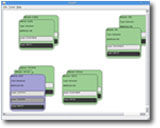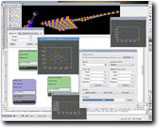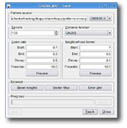Example simulator
This simulator was the original start point for the development. But soon the mixture of GUI code and network simluator functionality made the project difficult to handle. At this point we decided to split TIKAPP in several parts.
The discontinued simulator is still available because it contains a lot of interessting ideas and demonstrates a number of features (like the 3d-viewer) that will be available as a separate application in the future.
Features
- modular (module = a single teachable network of a provided network type, can be connected to build an information processing network)
- different types of networks (backpropagation, kohonen self-organized maps, filter-network)
- open and save network projekts (stored in XML)
- read XML input-pattern files for each module (pattern files can be: image files (png, jpg, xpm, ...), .wav files or csv-text)
- an OpenGl based 3D Viewer (all neurons have genuin 3D coordinates)
- object based menus, different networks provide deffernt features for learning, testing or visualisation
Source code
Source code is available as compressed tarball. To compile TIKAPP you need Qt3 and the corresponding development packages.
First download the sources and extract them. Go into the main directory of the sources and type qmake (Qt must be installed properly for this). Next type make and hit return. This will compile TIKAPP. When finished the binaries can be found in the bin directory.
Note for Windows users: Currently there is no free (GPL) version of the Qt library. This means, that neither binary packages for Win32 can be provided here nor can you compile TIKAPP under Win32 (because the Qt sources are missing). But there are at least two workarounds for this problem:
- Use a non-commmercial version of Qt3, which is included in the latest book about Qt from Trolltech.
- Install the cygwin environment for Win32 and use the X11 version of Qt3.
Tarballs
Documentation
There is a doxygen generated API-Reference here (in new window).
Screenshots
Click on the images to enlarge them.
 The sketchpad is the main working window it appears when TIKAPP is started. Every single network is represented by a container icon (colored boxes). Each icon shows how many layers it contains (bars inside each box).
The sketchpad is the main working window it appears when TIKAPP is started. Every single network is represented by a container icon (colored boxes). Each icon shows how many layers it contains (bars inside each box).
 This screenshot gives a first impression of the TIKAPP multiwindow desktop. It shows several dialogs, plots, the sketchpad and the 3D viewer.
This screenshot gives a first impression of the TIKAPP multiwindow desktop. It shows several dialogs, plots, the sketchpad and the 3D viewer.
 Here the teach dialog for a kohonen network is depicted. Choose a pattern set, select how many epochs you will teach these patterns, select some running variables and hit teach.
Here the teach dialog for a kohonen network is depicted. Choose a pattern set, select how many epochs you will teach these patterns, select some running variables and hit teach.


